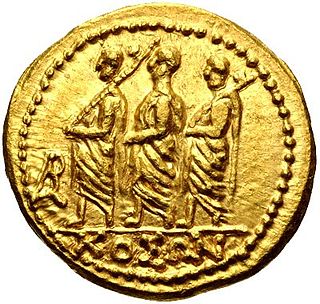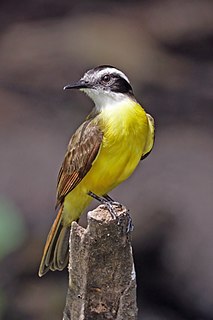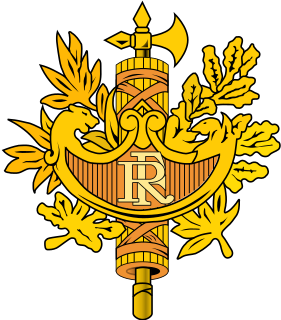Related Research Articles

The cursus honorum was the sequential order of public offices held by aspiring politicians in the Roman Republic and the early Roman Empire. It was designed for men of senatorial rank. The cursus honorum comprised a mixture of military and political administration posts; the ultimate prize for winning election to each 'rung' in the sequence was to become one of the two consuls in a given year. Each office had a minimum age for election; there were also minimum intervals between holding successive offices and laws forbade repeating an office.
Fasces is a bound bundle of wooden rods, sometimes including an axe with its blade emerging. The fasces is an Italian symbol that had its origin in the Etruscan civilization and was passed on to ancient Rome, where it symbolized a magistrate's power and jurisdiction. The axe originally associated with the symbol, the Labrys the double-bitted axe, originally from Crete, is one of the oldest symbols of Greek civilization. To the Romans, it was known as a bipennis.
In ancient Rome, imperium was a form of authority held by a citizen to control a military or governmental entity. It is distinct from auctoritas and potestas, different and generally inferior types of power in the Roman Republic and Empire. One's imperium could be over a specific military unit, or it could be over a province or territory. Individuals given such power were referred to as curule magistrates or promagistrates. These included the curule aedile, the praetor, the consul, the magister equitum, and the dictator. In a general sense, imperium was the scope of someone's power, and could include anything, such as public office, commerce, political influence, or wealth.

The decemviri or decemvirs were any of several 10-man commissions established by the Roman Republic.

A lictor was a Roman civil servant who was an attendant and bodyguard to a magistrate who held imperium. Lictors are documented since the Roman Kingdom, and may have originated with the Etruscans.
The magister equitum, in English Master of the Horse or Master of the Cavalry, was a Roman magistrate appointed as lieutenant to a dictator. His nominal function was to serve as commander of the Roman cavalry in time of war, but just as a dictator could be nominated to respond to other crises, so the magister equitum could operate independently of the cavalry; like the dictator, the appointment of a magister equitum served both military and political purposes.

The Sword of the Lictor is a science fantasy novel by American writer Gene Wolfe. First released in 1982, it is the third volume in the four-volume series The Book of the New Sun.

The lesser kiskadee is a species of passerine bird in the family Tyrannidae. It is the only species in the genus Philohydor. It is found in Brazil, Bermuda, Bolivia, Argentina, Colombia, Ecuador, French Guiana, Guyana, Panama, Peru, Suriname, Trinidad, Guatemala, and Venezuela. Its natural habitats are subtropical or tropical moist shrubland and swamps.
The Gabardini Lictor was a light aircraft developed in Italy in the mid-1930s. It was a low-wing cantilever monoplane with fixed, tailwheel undercarriage and a fully enclosed cabin. Two versions were built, the Lictor 90 with a 90 hp (67 kW) Fiat engine, and that Lictor 130 with a 130 hp (97 kW) Alfa Romeo 110, a de Havilland Gipsy Major engine built by Alfa Romeo. Development was abandoned in early 1936 when the firm was absorbed by Fiat.

The Muslim Association of the Lictor was created in 1939 as the Muslim branch of the National Fascist Party of Italy. It was found mainly and largely in Italian Libya. It was dissolved by the Allies during the invasion of Italy in 1943.

The Lictors Bring to Brutus the Bodies of His Sons is a work in oils by the French artist Jacques-Louis David. On a canvas of 146 square feet, this painting was first exhibited at the Paris Salon in 1789. The subject is the Roman leader Lucius Junius Brutus, founder of the Roman Republic, contemplating the fate of his sons. They had conspired to overthrow the republic and restore the monarchy, and Brutus himself was compelled to order their deaths. In doing so, Brutus became the heroic defender of the republic, at the cost of his own family. The painting was a bold allegory of civic virtue with immense resonance for the growing cause of republicanism. Its themes of virtue, sacrifice, and devotion to the nation sparked much controversy when it was unveiled in the politically charged era of the French Revolution.

Albanian Lictor Youth was a youth organization which served as the youth wing of the Albanian Fascist Party. The Albanian Lictor Youth was one of the associated organizations of the Albanian Fascist Party, as stipulated in its statute, which was formulated in a decree of the Italian vicegerent issued on 2 June 1939.
Arab Lictor Youth was a fascist youth organization for Arab youth in Italian Libya.
Ethiopian Lictor Youth was a fascist youth organization in Ethiopia.

Periaptodes frater is a species of beetle in the family Cerambycidae. It was described by Van der Poll in 1887. It is known from the Solomon Islands, New Britain, and possibly Australia.
Periaptodes olivieri is a species of beetle in the family Cerambycidae. It was described by James Thomson in 1864. It is known from Moluccas.
Periaptodes paratestator is a species of beetle in the family Cerambycidae. It is known from Stephan von Breuning in 1980.
Periaptodes potemnoides is a species of beetle in the family Cerambycidae. It was described by Kriesche in 1936.
Periaptodes testator is a species of beetle in the family Cerambycidae. It was described by Francis Polkinghorne Pascoe in 1866. It is known from Indonesia, Papua New Guinea, and possibly also Australia.

The diplomatic emblem of France is an unofficial emblem that was adopted in 1913 by the French Foreign Ministry as a symbol for use by French diplomatic missions and consular posts abroad. It was based on an earlier design by the sculptor Jules-Clément Chaplain. The emblem also appears on the cover of French passports.
References
- ↑ BioLib.cz - Periaptodes lictor. Retrieved on 8 September 2014.